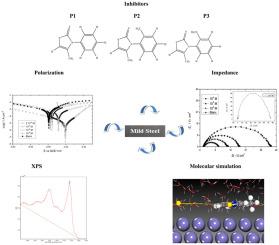Colloids and Surfaces A: Physicochemical and Engineering Aspects ( IF 4.9 ) Pub Date : 2021-09-23 , DOI: 10.1016/j.colsurfa.2021.127556 O. Benali 1 , M. Zebida 1 , F. Benhiba 2, 3 , A. Zarrouk 3 , U. Maschke 4

|
Carbon steel (CS) corrosion prevention is a significant problem in the industry. The development of an effective protection strategy is a popular research area. In this work, three thiazole derivatives (3-(2-methoxyphenyl)−4-methylthiazol-2(3H)-thione (P1), 3-phenyl-4-methylthiazol-2(3H)-thione (P2) and 3-(2-methyl-phenyl)−4-methylthiazol-2(3H)-thione (P3)) were used in 0.5 M H2SO4 solution for CS corrosion mitigation. Weigh loss and electrochemical tests were used to assess their corrosion prevention effectiveness, while X-ray photoelectron spectroscopy was used to examine the steel surface (XPS). Electrochemical tests showed an inhibition efficiency between 90.1% and 98.4% for CS exposed to acidic solution containing 2 × 10−4 M of the three thiazole derivatives. The three inhibitors were categorized as mixed type inhibitors since they inhibited both cathodic and anodic corrosion and they follow the Langmuir isotherm. XPS showed that inhibitor molecules formed a stable layer on steel surface through chemical and physical interactions. Furthermore, these experimental outcomes are well complemented from results analyzed by quantum chemistry calculations. Additionally, MD simulation outcomes helped in visualization of the adsorbed configuration of these compounds on the metal surface.
中文翻译:

噻唑基分子在 H2SO4 0.5 M 介质中抑制碳钢腐蚀:失重、电化学、XPS 和分子建模方法
碳钢 (CS) 防腐蚀是工业中的一个重大问题。制定有效的保护策略是一个受欢迎的研究领域。在这项工作中,三种噻唑衍生物(3-(2-甲氧基苯基)-4-甲基噻唑-2(3H)-硫酮(P1)、3-苯基-4-甲基噻唑-2(3H)-硫酮(P2)和3- (2-甲基-苯基)-4-甲基噻唑-2(3H)-硫酮 (P3)) 用于 0.5 MH 2 SO 4溶液中以减轻 CS 腐蚀。失重和电化学测试用于评估其防腐蚀效果,而 X 射线光电子能谱用于检查钢表面 (XPS)。电化学测试表明,CS 暴露于含有 2 × 10 -4三种噻唑衍生物的M。这三种抑制剂被归类为混合型抑制剂,因为它们同时抑制阴极和阳极腐蚀,并且遵循朗缪尔等温线。XPS 表明抑制剂分子通过化学和物理相互作用在钢表面形成了稳定的层。此外,这些实验结果很好地补充了量子化学计算分析的结果。此外,MD 模拟结果有助于可视化这些化合物在金属表面上的吸附构型。









































 京公网安备 11010802027423号
京公网安备 11010802027423号